Buchenwald Concentration Camp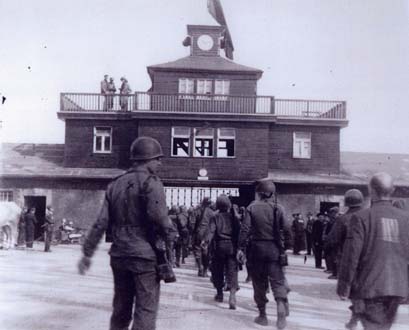 The photo above shows American soldiers entering the main gate of the Buchenwald concentration camp after it was liberated on April 11, 1945 by the US Army. This photo and all the other black and white photos on this page were contributed by Charles E. Becker who received them from the soldier shown in the foreground on the left in the photo above. Note the man on the right in the photo, who is wearing a suit jacket with a patch on the back. This looks like one of the prisoners who had to wear the letter N for "Nacht und Nebel," the term for the prisoners who were not allowed to communicate with anyone outside the camp. These prisoners were Resistance fighters who had been made to disappear into the "night and fog," and their families did not know what had happened to them. The photo below shows US soldiers watching as two prisoners climb up on a wagon full of corpses that were to be taken for burial in mass graves. On the left side in the background is a prefabricated horse barn of the type which was used for barracks in the Quarantine camp, also known as "The Small Camp." There was a typhus epidemic in the camp and prisoners in the Quarantine camp were still dying at the rate of more than 100 per day after the camp was liberated. 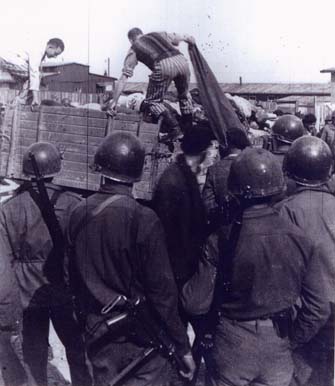 Charles E. Becker, who contributed these photos, wrote the following in a letter to us: Please accept them for display and as a reminder of the brutal creatures that caused this agony on so many innocent people. The terrible destruction caused by the leaders of Hitler's Germany is unmatched in all history. The will of those to survive the concentration camps is a demonstration of a people's determination against all odds to survive and go on living in a better world. The photo below shows prisoners milling around in front of the crematorium building at Buchenwald after the camp was liberated. Note the huge brick chimney on the right. The Communist prisoners in the camp were allowed to wear civilian clothes, instead of the usual striped prison uniforms. All but the NN prisoners were allowed to receive packages from home which could contain food and clothing.  The photo below shows bodies piled up beside the crematorium building. This is a very early photo which shows only one pile of bodies. Later photos show two much larger piles of bodies in the same spot and two wreaths hung below the windows. Note that the bodies were stacked so that the heads and feet alternated in each layer. The American soldiers described them as being "stacked like cordwood." The two bodies in the foreground are still clothed, which indicates that they died after the Americans arrived, and their uniforms were no longer needed for the other prisoners. 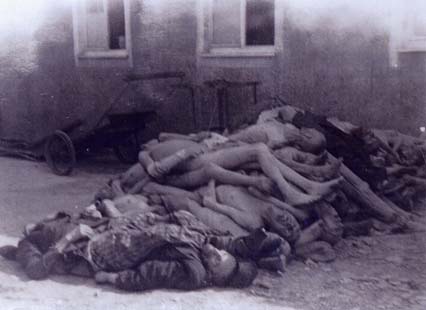 The photo below shows more bodies stacked up at Buchenwald, including one in the foreground that is still clothed in a striped uniform. Some people have questioned whether the photos taken of the bodies in the camps were authentic since there are no tattoos shown on the arms. Only the Jewish prisoners at Auschwitz were tattooed; the political prisoners in the camps in Germany did not have their prison number tattooed on their arm.  The photo below shows Buchenwald prisoners, after they were liberated by American troops. The prisoners appear to be relieving themselves on the ground outside one of the SS barracks buildings. After the camp was liberated, the survivors were moved to the SS barracks. 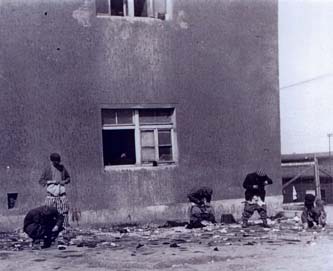 Buchenwald had flush toilets and wash basins in the prisoners' barracks, although the prisoners sometimes didn't bother to use them. Before the Americans arrived, the SS had tried to enforce strict rules about hygiene in an effort to stop the spread of disease, but they were not always successful. Robert Abzug wrote in his book entitled "Inside the Vicious Heart," that the American soldiers were "bewildered" by the behavior of the liberated prisoners. The following quote is from "Inside the Vicious Heart": Despite what they knew about what their wards had undergone, some Americans never ceased to wonder why, even after food had been made readily abundant, the survivors pushed and shoved their way to the soup kettle or bread basket. Others were appalled to find some indifferent to nudity and personal cleanliness. Nor was it readily understood why many were slow to volunteer for work, even though it might help the condition of the camp. The photo below shows one of the survivors of Buchenwald, who appears to be "indifferent to nudity." A tree in the background shows that this photo was taken in early Spring. Notice the resemblance to the man on the lower left in the second photo below. The second photo was contributed by Bob Landino and it is also shown on the previous page of this web site. 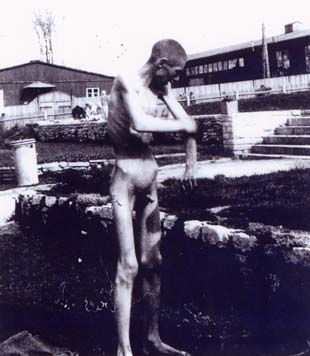 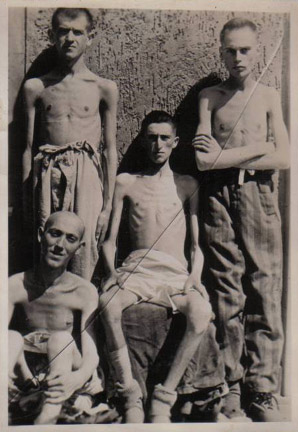 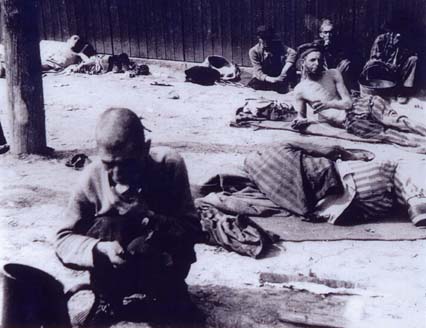 The photo above shows some of the survivors of Buchenwald relaxing outside the prisoners' barracks. Buchenwald had many Gypsy prisoners who had been brought there after the "Family Camp" for the Gypsies at Auschwitz was closed. Robert Abzug wrote the following about the reaction of the American liberators to the prisoners: Survivors in somewhat better health, whose personal habits approximated normality, disappointed in other ways. Naive Americans who thought that the camp experience might bring a certain unity and spirit of tolerance were puzzled to find that it seemed to have bred quite opposite traits. Though survivors all, Germans still looked down on Russians and Poles; Poles still hated the Jews; and everyone seemed to despise Gypsies. [...] The Jews were another story. The camps had taken their toll, and when survivors were herded into their new quarters in old army barracks and the like, they had not yet recovered from past physical and mental trauma. U.S. Army inspectors found that the Jews could not keep their camps in order - kitchens were filthy, living quarters were overcrowded and in shambles, and human excrement littered hallways and cooking areas. Nor to the average American on the scene did they appear overly virtuous. The Jews seemed distrustful of just about everyone, avoided work, and seemed interested only in what they could procure in the way of food and clothing. Old anti-Semitic stereotypes blended with these scenes of degradation to leave a rather unfavorable impression on many in the occupation force. The photo below was included in the collection of photos sent to us by Charles E. Becker. Note the trees in the background which do not yet have leaves on the branches. The photo shows a street sign inside the Buchenwald camp, which points to the Zoo that was located just outside the prison enclosure. Buchenwald had an SS garrison and training camp just like Dachau and Sachsenhausen, and the Zoo was for the amusement of the SS. The sign has figures of bears, which depict the bears in the Buchenwald Zoo. There were other signs, similar to this one, which pointed the way to other attractions in the Buchenwald camp. The signs have long since been taken down. 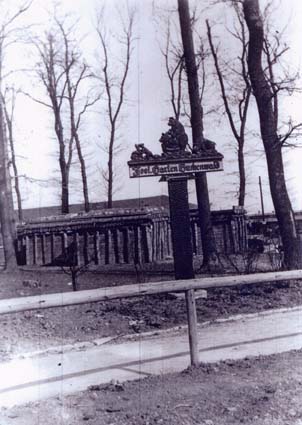 ContinuePreviousCongressmen & ReportersEdward R. Murrow ReportLiberation ClaimsBack to Buchenwald liberationHomeThis page was last updated on April 14, 2008 |